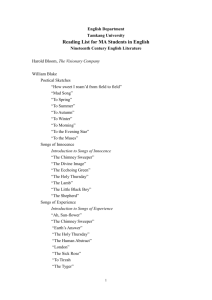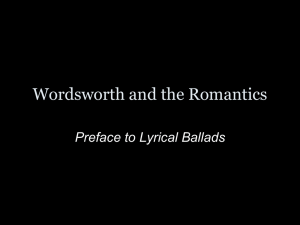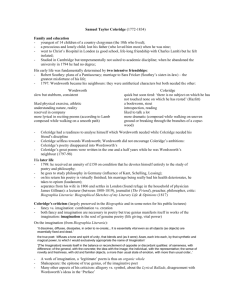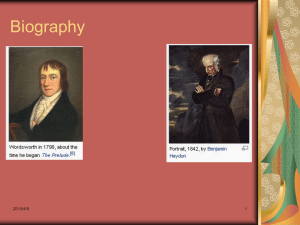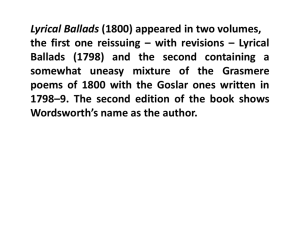Works
advertisement
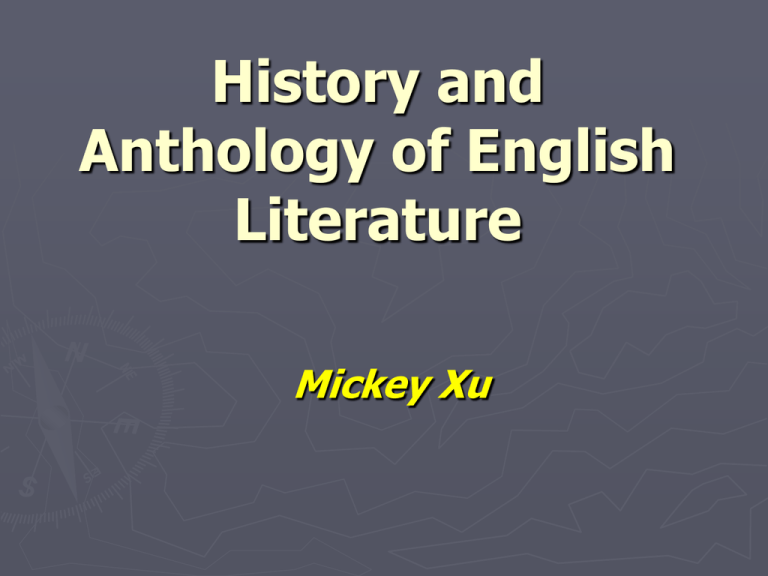
History and Anthology of English Literature Mickey Xu The Romantic Period Historical background: Industrial Revolution & French Revolution Thomas Paine’s “The Right of Man” was banned and he fled to France to escape the trail by the British government. ► Romanticism It refers to a European intellectual and artistic movement of the late eighteenth and early nineteenth centuries that sought greater freedom of personal expression than that allowed by the strict rules of literary form and logic of the eighteenth-century neoclassicists. The Romantics preferred emotional and imaginative expression to rational analysis. They considered the individual to be at the center of all experience and so placed him or her at the center of their art. The Romantics believed that the creative imagination reveals nobler truths — unique feelings and attitudes — than those that could be discovered by logic or by scientific examination. Both the natural world and the state of childhood were important sources for revelations of "eternal truths." ► The First Generation of Romanticist Poets I. Lake Poets: The first generation of Romantics include Wordsworth, Coleridge and Southey. They were also called “Lake Poets” because they had lived for a time in close association in the mountainous Lake District in the northwest of England. They are regarded as one group also because of their community of literary and social outlook. They traversed the same path in politics and in poetry, beginning as radicals and closing as conservatives. ► II. William Wordsworth life: William Wordsworth was born April 7, 1770, in Cockermouth, Cumberland(a shire). The next year he met Coleridge, and the three of them grew very close, the two men meeting daily in 1797-98 to talk about poetry and to plan Lyrical Ballads, which came out in 1798. The three friends travelled to Germany that fall, a trip that produced intellectual stimulation for Coleridge and homesickness for Wordsworth. After their return, William and Dorothy settled in his beloved Lake district, near Grasmere. Durham University granted him an honorary Doctor of Civil Law degree in 1838, and Oxford conferred the same honor the next year. When Robert Southey died in 1843, Wordsworth was named Poet Laureate. He died in 1850, and his wife published the much-revised Prelude that summer. ► works: ﹡Lyrical Ballads: In 1789, Wordsworth and Coleridge jointly published the “Lyrical Ballads”. The Preface of the Lyrical Ballads: The manifesto of the English Romantic Movement in poetry. “His short lyrics: “I Wandered Lonely as a Cloud” “Intimations of Immortality” “Lines Composed a Few Miles Above Tintern Abbey” “The Solitary Reaper” The Prelude: autobiographical, in 14 books, the spiritual record of the poet’s mind. ► Style: ﹡Simplicity, vivid imagery, directness of language, and unadorned beauty. ﹡Wonderful descriptions of nature, “Nature Poet”. Byron(1788--1824) Byron(1788--1824) ► Life: born on 22 January 1788 in London. At the age of 11 he inherited the title Lord Byron from his uncle and he went back to England. He was handsome but born with a misformed foot, which probably affected his disposition. He was compared to a roaring lion. In 1809, he started a tour around the Europe and the East. He went through Portugal, Spain, the Mediterranean, Turkey, Albania, Asia Minor. The result was his Childe Harold’s Pilgrimage, a great success. In 1815, he got married. During his tour in Europe, he befriended Shelly who infulenced Byron’s later works. After the death of Shelly, he went to Greece to help the Greeks win their liberty. Works: Long narrative and dramatic poems: Childe Harold’s Pilgrimage: a long poem of four cantos, written in Spenserian stanza. This poem tells of Childe’s travel in Europe. Don Juan: It was written in Italy Lyrics: When We Two Parted She Walks in Beauty Summary ► Byron wrote this poem the morning after he had met his beautiful young cousin by marriage, Mrs. Robert John Wilmot. ► The poet admires the woman’s beauty. Don Juan: Byron’s masterpiece ► It was written in Italy during the years 1818---1823. It is 16,000 lines long, in 16 cantos, and was in ottava rima, each stanza containing 8 iambic pentameter lines rhymed abababcc. ► The story takes place in the latter part of the 18th century. Don Juan, its hero, is a Spanish youth of noble birth. The poem tells about the vicissitudes of his life and his adventures. Percy Bysshe Shelley Percy Bysshe Shelley ► Life: ► *He was born in 1792. His father was a conservative and narrow-minded country gentleman. ► *Before he was 18, he had written two romances and published a collection of poems。 ► *At 19, he married with a 16 year-old girl. The marriage was hasty and unsuitable, because she could not share his ideas. In 1814, they divorced. ► * He went to Ireland in 1812 and published in works ► ► ► *Queen Mab *The Revolt of Islam: a long poem in 1818. *Prometheus Unbound: his masterpiece, a lyrical drama in 4 acts. *The Masque of Anarchy: a political lyric. *Lyrics on Nature and Love: Ode to the West Wind. To a Skylark Love’s Philosophy. *A Defence of Poetry: Poetry, so far from being deteriorated and made powerless by the advance of civilization, is actually the indispensable agent of civilization. John Keats Life: ---He was born in 1795 in London. His father was a stable keeper. ---Before he was 15, both of his parents died and he started to be an apprentice to a surgeon. ---He made friends with Leigh Hunt, Hazlitt and Shelley in London and published some poems. His first collection of poems was published under the help of Shelley. ---In 1818 he started on a walking tour through England and Scotland, during which he witnessed the poverty and privations of the people. ---Keats also lived in poverty. When looking after his brother who was badly ill, Keats was stricken with the same illness. ---Keats fell in love with a young lass Fanny Browne but could not marry her on account of his poverty and illness. ---Shelley invited Keats to come to Italy for medical treatment. But shortly after his arrival in Rome he died in 1821. ►Works *long poems: EndymionIsabella The Eve of St. Agnes LamiaHyperrion: unfinished *Short poems Ode to Autumn Ode on Melancholy Ode in a Grecian Urn Ode to a Nightingale( the best) His Principle: Beauty in truth, truth in beauty Some Women Writers (Jane Austen, the Bronte sisters, Mrs. Gaskell and Gorge Eliot) Among the distinguished English novelists of the 19th century are several women. Women novelists began to appear in England during the second half of the 18th century. But some gifted women of the 19th century made such contributions to the development of the English novel that they have justifiably won their places in the front ranks of the brilliant realists headed by Dickens and Thackeray. These remarkable women novelists are Jane Austen, the Bronte sisters, Mrs. Gaskell and Gorge Eliot. ► Jane Austen (1775--1817) --lived and worked at the turn of the century. --daughter of a country clergyman, passed all her life in doing small domestic duties in the countryside. --refused to acknowledge that she was the author of her novels, which were published anonymously owing to the prejudice prevailing at the time concerning the writing of novels by a lady. --living a quiet life in the countryside, she kept her eyes steadily upon the people and incidents about her, and wrote about the small world she lived in. Pride and Prejudice ► Work --six novels: Northanger Abbey Sense and Sensibility Pride and Prejudice (the most widely read among them) Mansfield Park Emma Persuasion ►Themes Theme is the fundamental and often universal idea explored in a literary work. The term is used interchangeably with thesis. ► ---Love ---Reputation Analysis of Major Characters Elizabeth Bennet she is lovely, clever. Nevertheless, her sharp tongue and tendency to make hasty judgments often lead her astray. Fitzwilliam Darcy Intelligent and forthright, he too has a tendency to judge too hastily and harshly, and his high birth and wealth make him overly proud and overly conscious of his social status. ► Charles ► ► ► ► Lamb(1775--1834) Life: ﹡a lifelong friend of Coleridge, and an admirer and defender of the poetic creed of Wordsworth. ﹡But while the romantic poets were interested in nature and country life, Charles Lamb felt more at home in the city than in the wild nature. He passed all his days in London. He showed us a romantic imagination which can find its stimulus not only in nature and in country life but also in society and people. ﹡He is considered as the finest familiar essayist in England. (The familiar essay is characterized by its relaxed style, its conventional tone, and its wide range of subject matter. ) Works: Tales from Shakespeare (1818) Specimens of English Dramatic Poets Contemporary with Shakespeare(1808) Essays of Elia (1820) Last Essays of Elia ► Features: He is a humorist and a master of puns and jokes, which abounds in his essays. He is fond of old writers. His writings are full of archaisms. His essays are intensely personal. His romanticism is different from Wordsworth’s. He was a romanticist of city, and his imagination was inspired by the busy life of London. Sir Walter Scott (1771-1832), Scottish writer and poet and one of the greatest historical novelists. Works: ► He is regarded as the founder and great master of the historical novel. 1).the group of novels on the history of Scotland: Waverley (1814), Guy Mannering (1815), Old Morality (1816), Rob Roy (1817) 2). The group of novels on English History: Ivanhoe (1819), famous for the realistic description of the life of feudal England. 3). The group of novels on the history of European countries: Quentin Durward (1823) St. Ronan’s Wells (1823): the only novel of Scott’s which deals with his contemporary life. ► His influence: Scott’s historical novels combine a romantic atmosphere with a realistic description of historical background, thus paving the way for some of the best works of Dickens and Thackery. In fact, his literary career marks the transition from romanticism to realism in English literature of the 19th century.
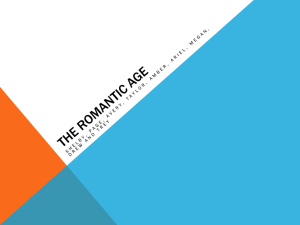
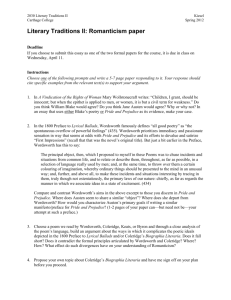
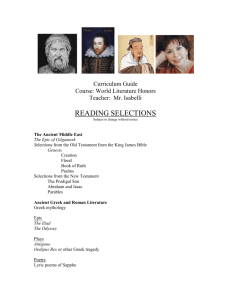
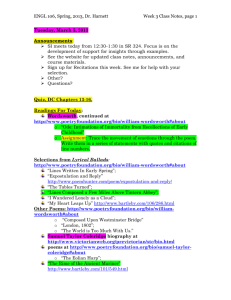
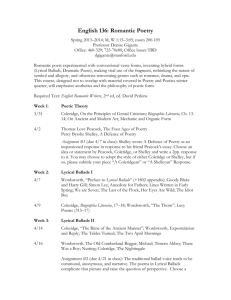
![William Wordsworth [1770-1850]](http://s3.studylib.net/store/data/008052186_1-5bee167b2781418a102ffc4b5551837f-300x300.png)
